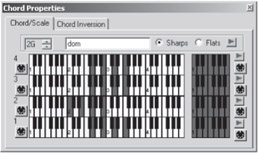Making Our Music Cooler
Play the Segment and notice that both the bass and melody move in a linear fashion. That is, when the chord changes from C7 to F7, both lines move up a fourth in parallel. If two musicians were to play this, it is unlikely that they would move through these changes in such a strict parallel fashion. DirectMusic allows us a number of ways to specify how a given part should move through the chord changes.
Open the properties page onto the F7 chord. Notice that there are four different chord and scale levels. Use these different levels to specify alternate ways in which DirectMusic should interpret the chord. On the second level of the chord, change the chord mapping so that the top two notes of the chord are on the bottom of the chord. It should now be composed of C, Eb, F, and A, which is the second inversion of the chord. For the G7 chord, set the second chord to the second inversion as well (in this case, C, E, G, and B). Your chord should look like this:

Figure 5-7: Setting up alternate ways for DirectMusic to interpret the G7 chord.
Now go back to your melody Segment file, right-click on an area of the pattern where no notes are found, and bring up the properties dialog. In the bottom, right-hand corner under Default Play Mode, set the chord level to Chord Level 2 so that this pattern follows the chord mappings specified in the second layer of the chord.

Figure 5-8: Adjusting chord levels.
Play MasterSegment.sgt again. Notice that while the bass is moving linearly through the chord change, the melody now uses the inversion to determine the root note of the melody. Save your project.
In case you are lost, there is a completed version of this section of the tutorial on the companion CD located in Unit I\Chapter 5\Tutorial Part One.
EAN: 2147483647
Pages: 170
- Challenging the Unpredictable: Changeable Order Management Systems
- ERP System Acquisition: A Process Model and Results From an Austrian Survey
- The Second Wave ERP Market: An Australian Viewpoint
- The Effects of an Enterprise Resource Planning System (ERP) Implementation on Job Characteristics – A Study using the Hackman and Oldham Job Characteristics Model
- Data Mining for Business Process Reengineering